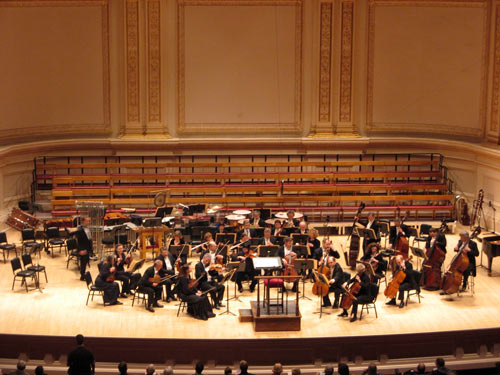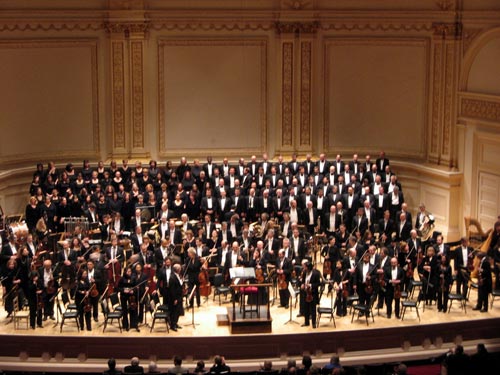Tag: Thomas Quastoff
BSO’s Bolcom @ Carnegie Hall
Back in the second tier boxes for the third and final of the Boston Symphony Orchestra’s concerts at Carnegie Hall this season. The BSO’s current music director James Levine is dear to New Yorkers for his relationship with the Metropolitan Opera, where he has led the orchestra since 1971.
The program at Stern Auditorium was to include two works by Franz Schubert and the New York debut of William Bolcom‘s Eighth Symphony for Chorus and Orchestra on William Blake’s Prophetic Books. That piece, which was commissioned by Levine for the BSO’s 125th Anniversary, had its world premiere the week before, in Boston.
German bass-baritone Thomas Quastoff had been scheduled to perform a series of five songs by Schubert, but like SC, he was derailed by illness and could not appear. (In SC’s stead, JG valiantly stepped in to accompany me to this evening’s concert.) Quasthoff is most visibly recognizable for his physical disability; he has a full-size torso, but shortened, malformed arms and stands at just under four feet tall as a result of his mother’s Thalidomide use during pregnancy. (His life story has inspired a movie.) Quasthoff has won three Grammys for his Deutsche Grammophon recordings, and last month won a fourth with EMI Classics for “Best Choral Performance” in Brahms: “Ein Deutsches Requiem”, conducted by Simon Rattle.
So instead, we were presented with Brahms’s violin-less Serenade No. 2 after Schubert’s “Tragic” Symphony No. 4.

After intermission, the stage filled to near-overflowing for the Bolcom piece, which called for full strings and winds, extensive percussion and keyboards, and the Tanglewood Festival Chorus. (The Times and The Sun weigh in, positively.)
Bolcom’s best-known composition is another Blake inspiration, “Songs of Innocence and of Experience,” for which he won three 2006 Grammys, including “Best Classical Contemporary Composition.” The same year, the University of Michigan Professor of Composition was awarded the National Medal of Arts.
His Eighth Symphony began with a literal bang — jarring audience members in their seats — eventually settling into near musical rhythms. I was impressed that the chorus performed the whispering, wailing four-movement piece entirely from memory.

| S | M | T | W | T | F | S |
|---|---|---|---|---|---|---|
| 1 | 2 | 3 | 4 | 5 | ||
| 6 | 7 | 8 | 9 | 10 | 11 | 12 |
| 13 | 14 | 15 | 16 | 17 | 18 | 19 |
| 20 | 21 | 22 | 23 | 24 | 25 | 26 |
| 27 | 28 | 29 | 30 | |||
Search
Popular Tags
Categories
Archive
- July 2010
- July 2009
- January 2009
- November 2008
- September 2008
- August 2008
- July 2008
- June 2008
- May 2008
- April 2008
- March 2008
- February 2008
- January 2008
- December 2007
- November 2007
- October 2007
- September 2007
- August 2007
- July 2007
- June 2007
- May 2007
- April 2007
- March 2007
- February 2007
- January 2007
- December 2006
- November 2006
- October 2006
- September 2006
- August 2006
- July 2006
- June 2006